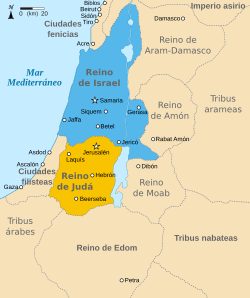
Back Koninkryk Israel Afrikaans مملكة إسرائيل (الشمالية) Arabic مملكة اسرائيل الشماليه ARZ شومالی ایسرائیل شاهلیغی AZB Ізраільскае царства Byelorussian Израилско царство Bulgarian ইসরায়েল রাজ্য Bengali/Bangla Rouantelezh Israel Breton Kraljevstvo Izrael BS Regne d'Israel Catalan
| Reino de Israel ממלכת יִשְׂרָאֵל Mamlejet Israel | |||||||||||||||||||||||||||||||
|---|---|---|---|---|---|---|---|---|---|---|---|---|---|---|---|---|---|---|---|---|---|---|---|---|---|---|---|---|---|---|---|
| Estado de la antigüedad | |||||||||||||||||||||||||||||||
| 928 a. C.-722 a. C. | |||||||||||||||||||||||||||||||
 | |||||||||||||||||||||||||||||||
| Coordenadas | 32°16′34″N 35°11′42″E / 32.276111111111, 35.195 | ||||||||||||||||||||||||||||||
| Capital | Samaria (880-c. 720) | ||||||||||||||||||||||||||||||
| Entidad | Estado de la antigüedad | ||||||||||||||||||||||||||||||
| Idioma oficial | Hebreo antiguo, arameo | ||||||||||||||||||||||||||||||
| Religión |
Yahvismo Politeísmo cananeo | ||||||||||||||||||||||||||||||
| Historia | |||||||||||||||||||||||||||||||
| • 928 a. C. | Revuelta de Jeroboam | ||||||||||||||||||||||||||||||
| • 722 a. C. | Caída de Oseas | ||||||||||||||||||||||||||||||
| Forma de gobierno | Monarquía | ||||||||||||||||||||||||||||||
| Rey |
Jeroboam I (1.er rey) Oseas (último rey) | ||||||||||||||||||||||||||||||
| |||||||||||||||||||||||||||||||
El reino de Israel, reino del norte o reino de Samaria (en hebreo: ממלכת יִשְׂרָאֵל, Mamlejet Isra'el) fue un Estado del Levante mediterráneo durante la Edad de Hierro. Tras dos décadas de ataques e invasiones por parte del Imperio asirio, Israel finalmente fue conquistada y el rey Sargón terminó exiliando una porción de sus habitantes.
Según el Tanaj (y, por ende, el Antiguo Testamento), fue el sucesor de la parte norte del reino unificado de Israel, dividido tras la muerte de Salomón, mientras la parte sur fue llamada reino de Judá. Actualmente no hay consenso sobre si Judá se desarrolló como una división del reino de Israel o de forma independiente.[1][2]
- ↑ Katz, Reinhard Gregor (2015). Historical and Biblical Israel. Oxford University Press. p. 27. ISBN 9780198728771.
- ↑ Mazar, Amihai. «Archaeology and the Biblical Narrative: The Case of the United Monarchy». Archaeological and Biblical Perspectives. «For conservative approaches defining the United Monarchy as a state “from Dan to Beer Sheba” including “conquered kingdoms” (Ammon, Moab, Edom) and “spheres of influence” in Geshur and Hamath cf. e.g., Ahlström (1993), 455–542; Meyers (1998); Lemaire (1999); Masters (2001); Stager (2003); Rainey (2006), 159–168; Kitchen (1997); Millard (1997; 2008). For a total denial of the historicity of the United Monarchy cf. e.g., Davies (1992), 67–68; others suggested a ‘chiefdom’ comprising a small region around Jerusalem, cf. Knauf (1997), 81–85; Niemann (1997), 252–299 and Finkelstein (1999). For a ‘middle of the road’ approach suggesting a United Monarchy of larger territorial scope though smaller than the biblical description cf. e.g., Miller (1997); Halpern (2001), 229–262; Liverani (2005), 92–101. The latter recently suggested a state comprising the territories of Judah and Ephraim during the time of David, which subsequently was enlarged to include areas of northern Samaria and influence areas in the Galilee and Transjordan. Na’aman (1992; 1996) once accepted the basic biography of David as authentic and later rejected the United Monarchy as a state, cf. id. (2007), 401–402.»